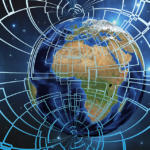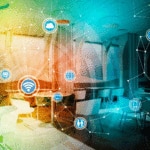What does the IoT need to become an essential part of our daily lives?
According to Business Insider, the number of connected devices will triple over the next three years. However, the Internet of Things still has to overcome many obstacles before it becomes an essential part of our daily lives. Standards, more consolidated platforms or the mass adoption of personal voice assistants are some of the tasks in which more progress needs to be achieved in the next five years.

The unstoppable progress of the Internet of Things (IoT) continues to help us lead connected lives at all times. This is one of the key conclusions of the latest edition of CES 2017, the biggest consumer electronic tradeshow in the world, which took place last month in the United States. An emerging technology that is evolving at increasing speeds, thanks to the potential offered by the real-time analysis of the constant stream of data generated by connected devices and which aims to make people’s lives easier.

According to experts, the number of devices connected to the internet will more than triple in the next three years, from 10 billion today to 34 billion by 2020, 24 billion of which will be IoT devices.
Speaking to BBVA, IoT expert César García, founder of Makespace, a digital fabrication space, put this booming trend into context: “Regarding the number of devices, a first estimate talked about 50 billion connected devices by 2020. This figure has dropped significantly over time, and now stands in the 20-30 billion range. It looked like users were just going to get rid of their non-connected devices to enjoy the advantages enabled by the new devices, but the actual replacement rate has been much lower: when they break, they are usually replaced with connected devices which offer new functionalities.” However, he notes, “the growth in the number of connected devices is still spectacular.”
The keys for the near future
According to these two specialists, several trends will be key in the next five-year period. The main one will be the adoption of personal voice assistants to interact with all our smart home devices. “Screens will no longer be the only way in which we can interact with connected devices. Solutions such as Amazon Echo (Alexa) or Google Now will enable more natural interaction and provide a simpler interface for less tech-savvy users” says García. “The trade-off is that all voice commands will be sent to the cloud for processing.”
Platform consolidation is another one of the trends mentioned by the expert. “In recent years, much of the work has been carried out based on models where each connected device came with its own application, didn’t speak to any other device and required having an extra device connected to the router. Little by little, a new wave of more consolidated platforms, such as Apple Homekit, is emerging, allowing end users to guarantee the compatibility of their devices without requiring them to resort to a specific app for each thing,” says García.
Another one of the points where progress is being made is the definition of specific IoT standards. “When the first connected devices started emerging, they relied on the existing connectivity standards. Recently, we have seen the emergence of a new series of specific solutions – low-consumption technologies – that optimize the battery life by minimizing the volume of data transfers,” says García.
“Besides the countless barrage of IoT services popping up in our daily lives, enabled by cheaper devices and communications services, from a more technological point of view, in the next few years we are going to see a consolidation in the communication networks and protocols that will be used within the IoT,” says Bruno Cendón – engineer and CTO of IoT startup TST – speaking to BBVA.
For Cendón “we will start seeing IoT convergence as soon as we can start talking about 5G, which should bring communication profiles capable of enabling applications in the world of IoT. Until then, the existing technologies and new technologies outside the standards, will fight for their slice of the IoT market.”

Furthermore, says Cendón, “the government should start viewing the IoT as a self-standing entity and that there are control and regulatory needs in key areas, such as cyber security or the use of unlicenced spectrums.” He is particularly critical of current policies: “Spain lacks a nationwide IoT strategy. Germany, France or the U.K. have already realized this are making efforts to support its development.”
Security, a sensitive matter
Security is one of the key challenges that the fully interconnected world is going to have to tackle, says García: “Several mass DDoS attacks have been launched in recent months using networks of zombie IoT devices. Many manufacturers have started taking measures to reduce this type of attacks, but until they are fully deployed it is more than likely that we will see more attacks aimed against key parts of the internet’s architecture.”
But he is not worried only about the attacks against the very foundations of the technology, but also about user privacy. “What happens when connected objects gather personal data constantly? Where are these data stored? How are they being used? The user agreements that come with many IoT devices are exploring how far they can push the limits of data usage, stating terms that many times are hard to grasp for the end-users themselves,” says the founder of Makespace.
In his opinion, this is another matter that deserves authority involvement. “Currently, there are many laws, hundreds of regulations, but the resources or willingness to implement them are lacking. If we stick to practical examples, we have personal data protection and cyber security laws,” says García. He also calls for users and companies to take responsibility: “If users are not concerned about security issues until they run into a serious problem, or companies do not invest in security resources because they don’t translate into better customer opinions, an overregulation in terms of conditions can limit the possibility for new agents to enter,” he emphasizes.
In the unstoppable progress of the Internet of Things, many companies will fall by the wayside, especially if their proposals, despite their connectivity, fail to offer any value to the end-user. By way of example, García talks about “Quirky’s Egg Minder, which informed users about the best-by date of a dozen eggs. The company did not prosper after launching several products with no apparent use.”
To build services that are both appealing for the user and profitable for the company, said Cendón to BBVA, “we need to reach a critical mass, but technologies – communication networks and device manufacturers - need to be ready to deliver. Will the forecasts prove accurate? I don’t know… according to figures the market seems to be growing, but we shouldn’t obsess over this issue as much as over the profitability and variety of IoT services.”
*If you are interested in this subject, connect with BBVA at LinkedIn to get related information and info on similiar topics.